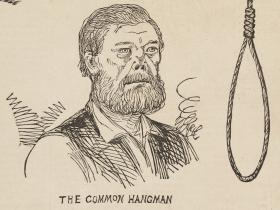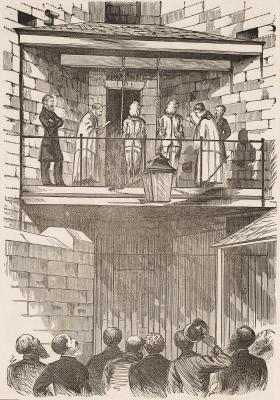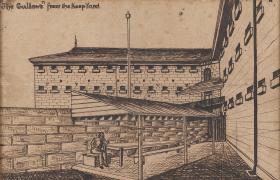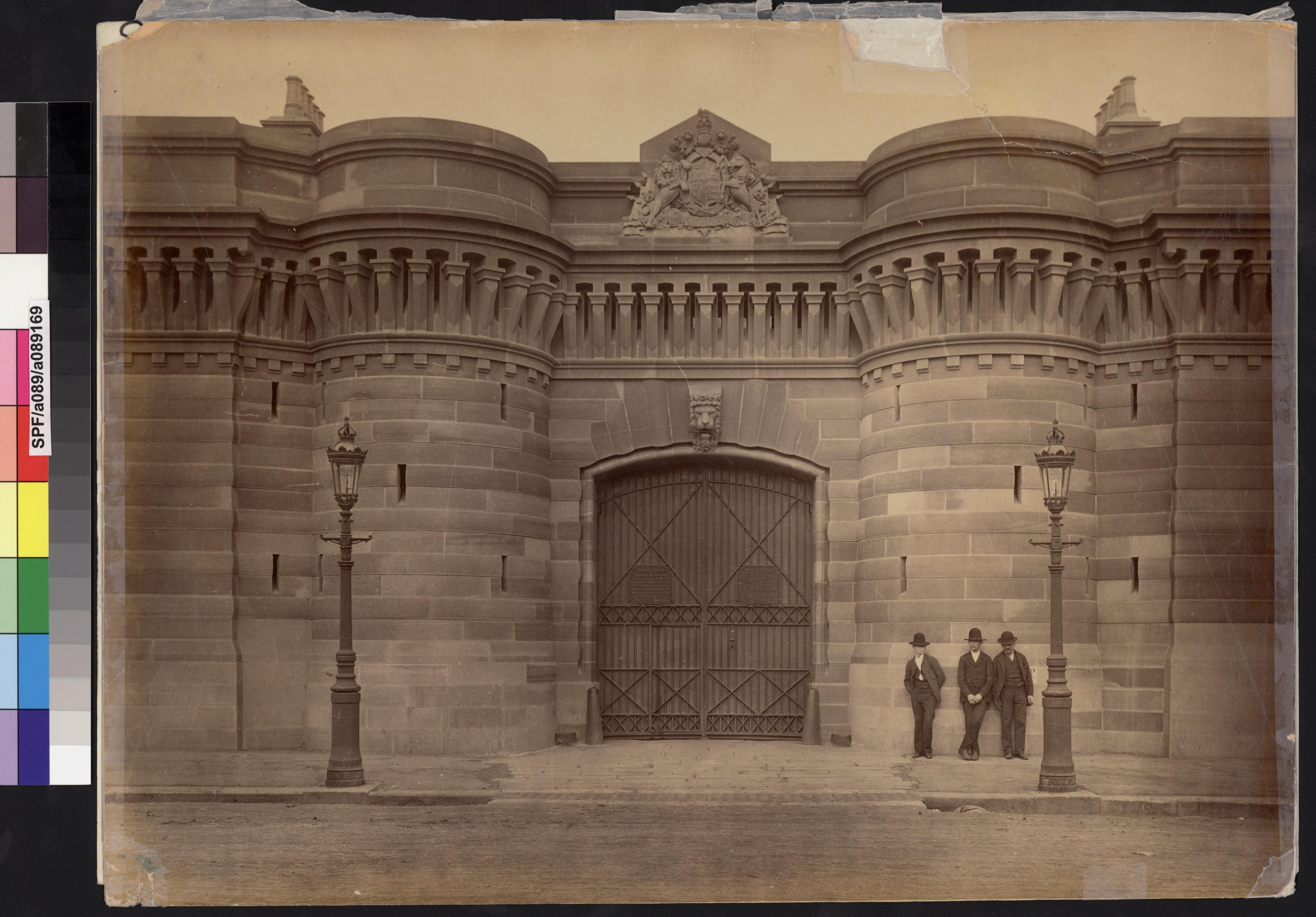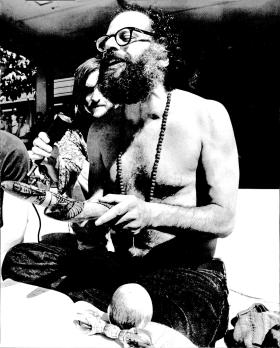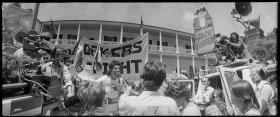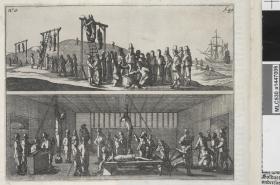The selection of a biographical subject is never straightforward. Inviting someone to live in your mind and in your soul for a few years is a complicated decision; even if you feel you know your topic well, those early days of courtship can be difficult. The biographer, typically, must bypass first-date questions around favourite books and preferred foods, and make more confronting enquiries around faith and politics. I also needed to ask in my case, how much money would you need to be paid before you killed a man?
For most, no cache of gold would ever force their hand to homicide. For Robert Rice Howard, however, the price for judicial execution was set at £156 per annum. The longestserving hangman for New South Wales may have never received a pay rise, but he was offered the occasional travel allowance in addition to his salary. First appointed as an assistant executioner in 1876 by the colony’s sheriff, Howard was quickly promoted to the top job. Across his years working on scaffolds, he hanged sixty-one men and one woman before he gave up the worst position on the government’s books in 1904. He had earned, roughly, £70 per noose fitting.
The colony’s most infamous public servant had been a successful Sydney cab driver in the mid-nineteenth century. Most printed accounts of Howard’s life state that he lost his nose after an altercation with a vicious horse. The damaged cabbie then lost much of his business, and the bloke who came to be known as ‘Nosey Bob’ took on the much-hated role of hangman. Howard, once handsome but now disfigured, may have felt that he did not have many options. A permanent position with the colony’s Department of Justice might have carried the shame of being the executioner, but it also offered financial security for himself and his family.
Becoming a hangman is hardly anyone’s childhood dream, just as writing about one is not an obvious choice for a biographer. Yet, Howard — a central component of the system of law and order during the days of the death penalty in New South Wales — is a fascinating case because he is shrouded in myths. One of the best-known stories about Nosey Bob, for example, is that he lost his nose after being kicked in the face by a horse. This is a story that has been told over and over, but it is also one that has never been proven. Another tale is that his daughters lived lives of lonely spinsterhood, because nobody wanted a hangman as a father-in-law.
It has also been widely assumed that Nosey Bob was an incompetent executioner who routinely botched his job. Instead of neatly breaking a person’s neck, it was said, Howard would compound the suffering of those who had been sentenced to death. Labelled the ‘Champion Choker’, quite a few of Nosey Bob’s clients were, regrettably, strangled slowly once the trapdoors of the scaffold gave way. There is no denying that Howard had the odd bad day at work, but the idea that he often bungled when he dealt with a felon is just another myth.
In fact, so much of what is generally accepted about the history of this important Sydney identity is confused and contradictory, demonstrating how easily myths can, over time, be accepted as truths. The newspaper editors and journalists of Howard’s day worked to exploit the executioner in debates for and against capital punishment. Fact and fiction often merged seamlessly with Nosey Bob who was easily recast as someone who was different, even evil. He was never just the hangman; he was always the noseless hangman.
Unfortunately, shifting fabrications to one side to find the truth is not as easy as pulling out a man’s personnel file. In contrast to many biographical subjects, Howard has no rich archive to raid. There are no shelves of boxes dedicated to the memory of his life or his work. He was, after all, just a hangman. As early as the 1870s there were complaints about the information that had, and had not, been kept about the executioners of Australia’s oldest colony.
Newspapers present a few facts and a lot of innuendo, with broadsheets and tabloids often serving as paper boxing rings for conflicting stories on Howard to fight it out. A careful review of thousands of articles does provide an outline of Nosey Bob, a hangman who was also a devoted family man. A keen gardener who loved his horse and his dog. This outline seems well defined at times, but it can quickly dissolve. There were days when I felt that Howard was sitting next to me, but all too often he was just a ghost.
So, how do you colour in a ghost? How do you bring a man, for a few hundred pages at least, back to life? There are documentary fragments of this hangman’s years that survive, but the specifics of what, where and when are scarce. Archives and libraries have preserved enough evidence to prove that Howard was born in early 1832 in Norfolk, England. It is also known that he married in his mid-20s and started a family before emigrating with his wife, Jane, and their three young children, to Australia in 1866. The Howard family grew when another child was born in Brisbane and two more children were born in Sydney. Contesting some of the common assumptions about Howard’s homelife, there were lots of weddings and many grandchildren.
Despite numerous disappointments — including missing correspondence, ledgers and reports — there is some information that details Howard’s career as an executioner. It is, perhaps, inevitable that a hangman’s life is lived through his deaths.
Nosey Bob hanged felons across New South Wales, but almost half of his work was completed behind the imposing sandstone walls of Darlinghurst Gaol where he dealt with some of the most famous criminals of colonial Sydney. On the gallows in the crook of ‘E’ Wing, near Darlinghurst Road, he dispatched Louisa Collins, accused murderer and the last woman executed in New South Wales, on 8 January 1889. He hanged Frank Butler, Australia’s first serial killer, on 16 July 1897. He also took care of murderer and bushranger Jimmy Governor, a First Nations man whose violent rebellion against racism saw him on the wrong side of the law, on 18 January 1901.
Through comparing published execution reports with the official records and to the interviews that Howard gave across the 28 years that he did the Sheriff’s dark work, I discovered a man unlike any of his predecessors. Though his profession was reviled, Howard was comparatively normal. Not your typical neighbour from across the street, but he was not the stereotypically cruel executioner either. He was a quiet man, occasionally cantankerous, but someone who was always ready to do a good deed. After his retirement Howard lived in his modest timber cottage at North Bondi, on Brighton Boulevard, just off modern-day Campbell Parade, where he had moved in the 1880s. He did a bit of fishing, and he enjoyed a drink. Nosey Bob famously trained a horse to carry a billy and make a round trip from his home to a local establishment; the billy carried a sixpence there and beer on the way back.
Nosey Bob passed away on 3 February 1906. When a short obituary on him appeared in Freeman’s Journal, two weeks after his death, it included a suggestion that the ‘stories told of Robert Rice Howard, the retired executioner of New South Wales, who died at Bondi the other day, would make an interesting book’. This idea of a book about Howard was one that I have thought about many times since I first came across his story in 2014. I would spend an hour or two every now and then searching for information and slowly rebuilding the life of a man who, now largely forgotten, was once Sydney’s most recognisable government official. As a pandemic circled the globe and tightened its grip, I spent more and more time with Mr Howard. In looking for a noseless hangman, I found much more than a distraction from a chaotic world; I found a friend.
Dr Rachel Franks is the Coordinator, Scholarship at the State Library. Her biography of Robert ‘Nosey Bob’ Howard, An Uncommon Hangman, will be published by NewSouth in May. Purchase a copy from the Library Shop.
See a selection of items relating to Robert Howard on display in the Amaze Gallery.
This story appears in Openbook autumn 2022.

